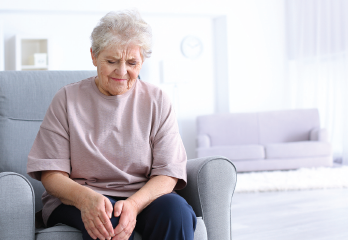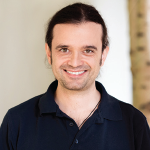
Africa Studio / shutterstock.com
Mounting evidence suggests that humans have a complex and integrated mind-body system. Knee problems may affect the spine and other body parts, but also the mind—and vice versa. This is the wisdom of Ayurveda, the 3,000-year-old traditional medicine from India.
A team of researchers from Germany recently undertook a study, titled “Effectiveness of an Ayurveda treatment approach in knee osteoarthritis—a randomized controlled trial,1” which appears in the May 2018 edition of Osteoarthritis and Cartilage.
Christian S. Kessler, MD, works in the Department for Complementary and Integrative Medicine at Charité University & Immanuel Hospital in Berlin, Germany. Along with colleagues from multiple countries, Dr. Kessler delved into the issue of how Ayurveda, widely used in India for a variety of ailments, is able to move the needle on the pain of osteoarthritis (OA).
He says, “Our institute is one of Europe’s largest facilities for the study and practice of complementary medical research. While I have been interested in traditional Indian medicine—Ayurveda—for over 20 years, it is only lately that clinical research on this multimodal practice is on the rise in the West. Given the need for concrete data according to the principles of evidence-based medicine, we thought it would be wise to undertake a randomized controlled trial.”
Why OA?
“Knee OA has a high economic burden and prevalence in Western countries and worldwide,” Dr. Kessler notes. “We took care to undertake a well-designed study that was adapted to the specifics of Ayurveda. Plus, in the case of OA, there is a substantial overlap between the Western diagnosis of OA and the diagnostic entity in Ayurveda known as sandhi-gata-vata. Ayurveda is not only nutrition and lifestyle, but an entire sophisticated medical system that makes use of a multimodal approach to individualize treatment according to Ayurvedic principles. While there has been previous clinical research purporting to address Ayurveda, almost all of these trials actually left out certain elements of Ayurveda therapy. This is our attempt to rectify that.”
In what was the first randomized controlled confirmatory study on the use of multimodal Ayurveda to treat knee OA, researchers enrolled 151 individuals (77 in the Ayurveda group and 74 in the conventional care group). Participants in the conventional group received multimodal and individualized conventional care for knee OA according to current guidelines. This included quadriceps muscle-strengthening exercises; knee-specific physiotherapy, including manual therapy; occupational therapy; advice for home knee exercises; dietary advice for weight loss for overweight participants; and, if necessary, administration of long-term pain medication according to current guidelines. The study, a head-to-head comparison between Ayurveda and conventional guideline-based OA treatment, did not include a placebo or a sham intervention.
Changes in the Western Ontario and McMaster University Osteoarthritis (WOMAC) Index were assessed after 12 weeks.
A Win for Ayurveda

Dr. Kessler
Dr. Kessler says, “We were quite surprised by the results. Both conventional and Ayurvedic treatment were successful. However, the Ayurveda group showed an effect of almost double that of the size of the effect of the conventional group for the primary outcome, resulting in a significant difference between the groups. This study found Ayurveda was superior to conventional guideline care for knee OA—which was already effective. It was not only statistically significant, but the effect size indicates that this is also clinically relevant.
“Among other secondary outcomes, we looked at the mental and physical subscales of the Short Form Survey 36 (SF-36) and found an interesting detail: On the mental component of the SF-36 there were no significant between-group differences, which was stunning because many people view complementary and alternative medicine as primarily (or only) exerting placebo effects. But that small detail hints that when it comes to mental quality of life, there is no significant difference between groups. However, the between-group difference for the physical subscale of the SF-36 was again significant. So we must assume that participants were not just reporting feeling great after Ayurveda therapy; … they reported very solid and sustainable physical improvements. It’s nice to see jubilant patients, but this small detail of the SF-36 supports what we saw with the WOMAC results—less pain and better movement.”
Take the Data to the Decision Makers
“This was no small pilot study,” says Dr. Kessler. “In this study, Ayurvedic treatment went head to head with conventional therapy in a country outside of India. This is an important point when discussing this with politicians or medical boards: We actually generated data on the effectiveness Ayurveda in Europe.
“It is important to take into account the setting here. … You’re not going to transform someone with a German lifestyle into someone with an Indian lifestyle,” he continued. “But you can transfer many of the timeless principles of Ayurveda to the specific needs of a German or an American. For example, dietary counseling can help people access food items useful for OA patients that are available in German supermarkets. We can’t make German knee OA patients eat curry every day, so we need to find alternatives that are still valid according to Ayurveda principles.
“According to Ayurveda theory there are three energetic forces, known as Vata, Pitta and Kapha. The system categorizes knee OA as a degenerative disease of the locomotive system thus Ayurveda theory says that Vata, the principle of kinetics, needs to be balanced. Thus, with these patients it would be important to stress the regularity and rhythm of food intake. They are advised to have food that is warm, soupy, easy to digest and freshly prepared.
“The patients in our study also benefitted from a procedure known as oleation, where medicated oil is applied from the outside and inside the body,” he said. “We also used poultices on the knee joints, involving specific techniques and oils. Knee yoga postures and Vata-reducing nutritional supplements, like ashwaganda and guggulu, were all part of the individualized treatment. All of these efforts were directed to the one goal of reducing the activity of Vata, thus balancing the kinetic principle of movement.”
Conclusion
With a solid 3,000-year old history of bringing relief to millions, Ayurveda has much to offer to the West.
Dr. Kessler says, “Far from quackery, this traditional medical system is similar to traditional Chinese medicine or Native American medicine and is a great supplement to conventional therapies. We are not advocating the use of Ayurveda instead of something else, but when you see physicians and patients who are unhappy with their progress, this provides an opportunity to add a ‘new’ and effective therapeutic element for the treatment of OA.”
Elizabeth Hofheinz, MPH, MEd, is a freelance medical editor and writer based in the greater New Orleans area.
Acknowledgment
This study would never have been possible without the work, input and advice of so many dedicated researchers and medical professionals from various countries. Particular thanks to all co-authors and the Indian Ministry of AYUSH for enabling us to perform this trial in Germany.
References
- Kessler CS, Dhiman KS, Kumar A, et al. Effectiveness of an Ayurveda treatment approach in knee osteoarthritis—A randomized controlled trial. Osteoarthritis Cartilage. 2018 May;26(5):620–630.
